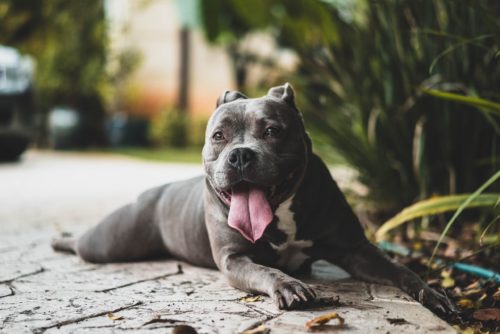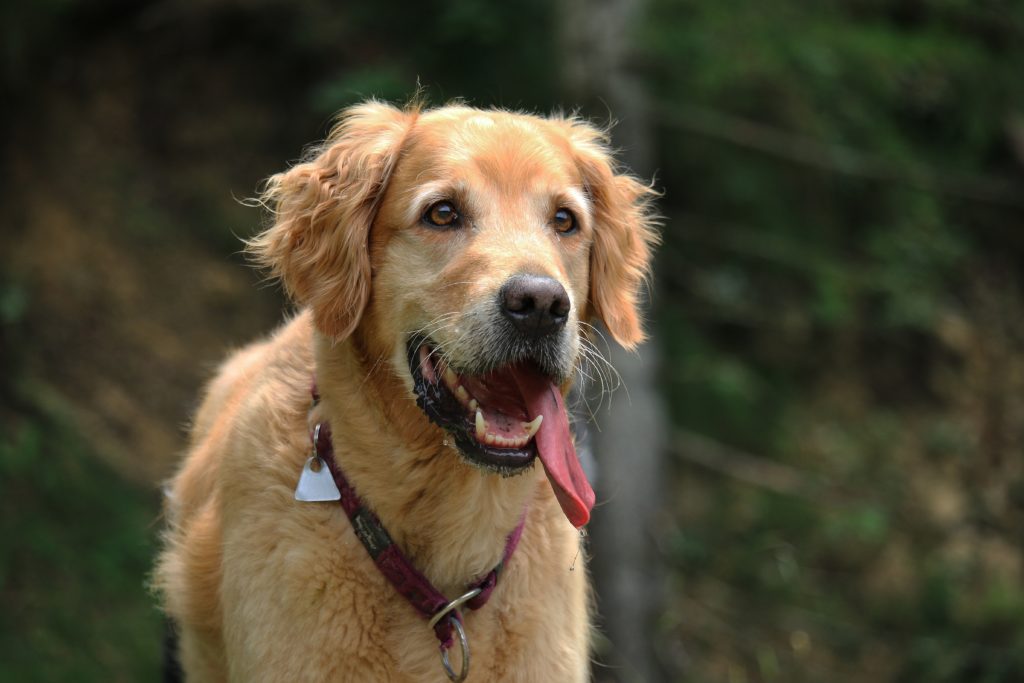Even though all dogs likely descended from a single type of canine ancestor, they have an awe-inspiring range of appearances. The American Kennel Club (AKC) recognizes 193 distinct breeds in its ranks – and that doesn’t even account for the huge number of newer cross-breeds, mixes, and mutts. With all that variety, unique features emerge in certain breeds and mixes: the Shiba Inu’s perpetually-curly tail, the Dalmatian’s iconic spots, and the Basset Hound’s droopy ears, to name a few. These breed-specific traits are well-known and anticipated by pet parents, but other less predictable attributes can cause concern.
The pink tongue of a happy dog is a familiar sight to anyone that’s spent time around canines, but a tongue with dark splotches can, to the untrained eye, look like a health issue. While the Chow Chow and Shar-Pei are the only two breeds that sport completely blue-black tongues, there are dozens more that seem to manifest spotty evidence of the same color without rhyme or reason. This article will focus on black spots on the tongue of a dog, including what they mean, when they’re normal, and when to be concerned.
Black Spots On A Dog’s Tongue: What Does It Mean?
In the vast majority of instances, a dog’s spotted tongue is no more a cause for concern than a human child being born with a birthmark. Because  most dogs are completely covered in fur, the idea of varied skin colorations seems odd: humans expect different fur colors, even in the same dog, but don’t often think about the skin underneath. Discolorations like freckles and birthmarks are just as common in dogs as people, and may show up on paw pads, hidden beneath fur, on lips and gums, and finally, on the tongue as well.
most dogs are completely covered in fur, the idea of varied skin colorations seems odd: humans expect different fur colors, even in the same dog, but don’t often think about the skin underneath. Discolorations like freckles and birthmarks are just as common in dogs as people, and may show up on paw pads, hidden beneath fur, on lips and gums, and finally, on the tongue as well.
These spots are easy to see because of the contrast they provide against a pink tongue, and tend to be irregular and asymmetrical if several spots appear. There’s no hard and fast rule for when the spots first become visible, but they are more common in puppyhood and young adulthood rather than later in a dog’s life. There is a strong correlation between the Finnish Spitz, Pointer, and Spaniel families of dog breeds and the appearance of tongue spots, though more than 40 breeds overall have been recorded as having spots on their tongue.
Dog Tongue Spots: Myths & Misinformation
For centuries, there is a lot of fact – and fiction – surrounding spots on a dog’s tongue regarding their significance, why they’re there, and even if they indicate a dog’s lineage. Below, some common misconceptions and facts about black spots on your dog’s tongue:
- Tongue spots in dogs are evidence of an injury or disease: The spots themselves are nothing more than a concentration of pigment, and don’t change the way a dog tastes his food any more than a freckle on the finger would change how humans perceive through touch. They are harmless and don’t represent anything ominous or concerning for the pup that has them.
- Tongue spots only appear in certain patterns: Dog tongue spots can be virtually any size, and may appear as one large spot or many smaller ones. They are often asymmetrical, and a dog is thought to be more likely to show tongue spots if his canine parents had them.
- If a dog has tongue spots, he isn’t purebred: This is a particularly persistent rumor, likely derived from the idea that unexpected “broken” color – coat, eyes, and so on – is generally frowned upon in show dogs. While it is true tongue color is part of some judging criteria in the AKC, it’s on the opposite side of the spectrum: Chow Chows and Shar-Peis that have pink spots on their tongue are considered less desirable as show dogs.
- A dog with a spotted tongue has Chow Chow in its lineage: This myth does make a lot of logical sense – a pup with some blue-black tongue spots coming from a dog with an all blue tongue. Even though it sounds plausible, it’s simply not true. The all-blue tongues found in Chows and Shar-Peis are the result of a hereditary trait, like a Dalmatian’s coat spots. Blue-black spotted tongues in other breeds are the result of random chance, like birthmarks. These two features look alike, but they actually have nothing to do with one another.
In short, tongue spots have no bearing at all on a dog’s health, happiness, abilities, attitude, or lineage: they’re simply dots of color on his tongue!
Did You Know: Interesting Facts About Dog Tongue Spots
- They’re usually born with them: Generally, a dog with tongue spots will manifest them as a young puppy. They may change slightly or darken in color as he grows into a young dog, but chances are he’ll have them for life.
- They’re supposedly lucky: Some hunters looking for their next hunting dog from a new litter will ascribe to an old wives’ tale and pick a
 puppy with tongue spots over one that does not have them. The belief is that these “tongue spotted” puppies will make better, more obedient, and smarter dogs out in the field. While there is, of course, no evidence of this, it remains a very popular superstition among breeders.
puppy with tongue spots over one that does not have them. The belief is that these “tongue spotted” puppies will make better, more obedient, and smarter dogs out in the field. While there is, of course, no evidence of this, it remains a very popular superstition among breeders. - They reflect the potential for colors elsewhere: In AKC terms, accent coloring in a dog is called his “points.” These points are found on his nose, the area around his eyes, on the pads of his paws, his toenails, and lips. Tongue spots are more common in breeds that display black or dark “points” over lighter ones; if a dog has tongue spots, he’s also more likely to show unique coloration in or around his points.
- They cannot be removed or changed: No alteration of diet will change a dog’s tongue spots, nor are there any safe, known methods of removing tongue spots. Like a colored blaze of fur at the chest, or a differently-colored paw pad, tongue spots are part of a unique collection of traits that give a dog his distinctive look.
There Are Black Spots On My Dog’s Tongue: Is It Dangerous?
While there are a number of discolorations that signal a health issue, regular tongue spots aren’t a cause for concern on the part of pet parents. They don’t cause a dog any discomfort or pain, they aren’t contagious, and they’re with him from puppyhood on: he’s very used to them. That doesn’t mean, however, that every dark spot in a dog’s mouth should be ignored.
As with many canine health concerns, determining if a problem exists comes down to time. A sudden appearance or change in a tongue spot, how dark that spot is, and especially the texture of the spot’s surface should always factor into consideration. If a spot is new, dark, spreading, or has a raised/broken surface, a vet should be consulted, as a biopsy of the spot may need to be taken. Likewise, if a dog is chewing oddly or avoiding his food due to what appears to be mouth pain, it’s a good idea to consult a vet for diagnosis and treatment.
Preventative Care: Keeping An Eye Out For Canine Tongue Spots
Most pet parents don’t get to see their dog’s tongue unless he’s drinking water or enthusiastically greeting them when they get home. Watching tongue spots for the potential trouble signs mentioned above means spending quality time with some doggie dental care. While experts recommend that owners brush their dog’s teeth every day, even managing to do so once or twice a week will help you spot any changes or growth in tongue spots. If you need tips on how to brush your dog’s teeth, talk to your vet for further instructions. Follow these helpful oral care tips for your pooch:
- Use a soft finger-mounted brush: Dogs are less likely to balk and fight at something new if it comes, quite literally, from the hand of their pet parent. He’s also less likely to chew or bite if he knows his parent is the one administering the brushing. For canines with anxiety, speak with a trusted vet to see if CBD supplements for dogs might be helpful.
- Opt for tasty toothpaste: A variety of doggie toothpastes are available that taste like beef, chicken, and other delectable flavors. He’ll think he’s getting a treat, even though his owner is getting peace of mind.
- Don’t force a dog to “like” it: Dental care for dogs can be a little touch-and-go, but that’s okay! Let your dog set his own pace for comfort, and stay on task with a dental routine. Eventually, he’ll come to expect it and even look forward to quality time with his human companion/dentist.
- Examine teeth, gums, lips, and tongue: Even if you’re confident his tongue spots haven’t moved, chipped teeth, a cut lip, and swollen gums could point to other health problems. If you notice anything looks wrong – or if your dog’s breath is particularly offensive – make an appointment with a veterinary dental specialist to get him examined.
Tongue spots are simply another part of a dog to love – a unique expression of his heritage, breed, and background, and for the superstitious pet owner, a lucky charm. Now that the tongue spot myths have been dispelled, it’s easier than ever to appreciate a few extra points of “bonus” color on a dog that’s already perfectly lovable!
Sources Cited:
1) Simons, Paula. “What is the Black Spot on my Dog’s Tongue?” K9 Of Mine.com, May 16, 2019, https://www.k9ofmine.com/what-is-black-spot-on-dogs-tongue/. Accessed February 3, 2020.
2) Burke, Anna. “What Are Those Black Spots on a Dog’s Tongue, Anyway?” American Kennel Club (AKC.org), April 26, 2015, https://www.akc.org/expert-advice/health/black-spots-on-a-dogs-tongue/. Accessed February 3, 2020.
3) “The Truth About Those Black Tongues.” Homeward Bound Animal Rescue (homewardbound2u.rescuegroups.org), (no publish date), https://homewardbound2u.rescuegroups.org/info/display?PageID=6944. Accessed February 3, 2020.
4) Mattinson, Pippa. “Black Spot On Dog’s Tongue – Tongue Spots in Labs and Other Dogs.” thelabradorsite.com, April 30, 2019, https://www.thelabradorsite.com/black-spot-on-dogs-tongue/. Accessed February 3, 2020.




